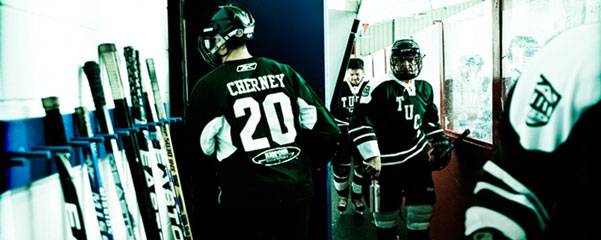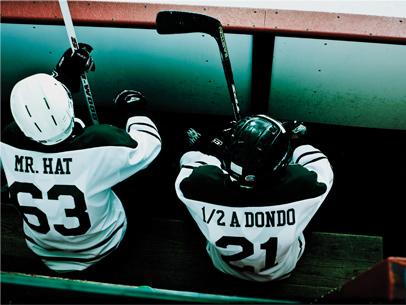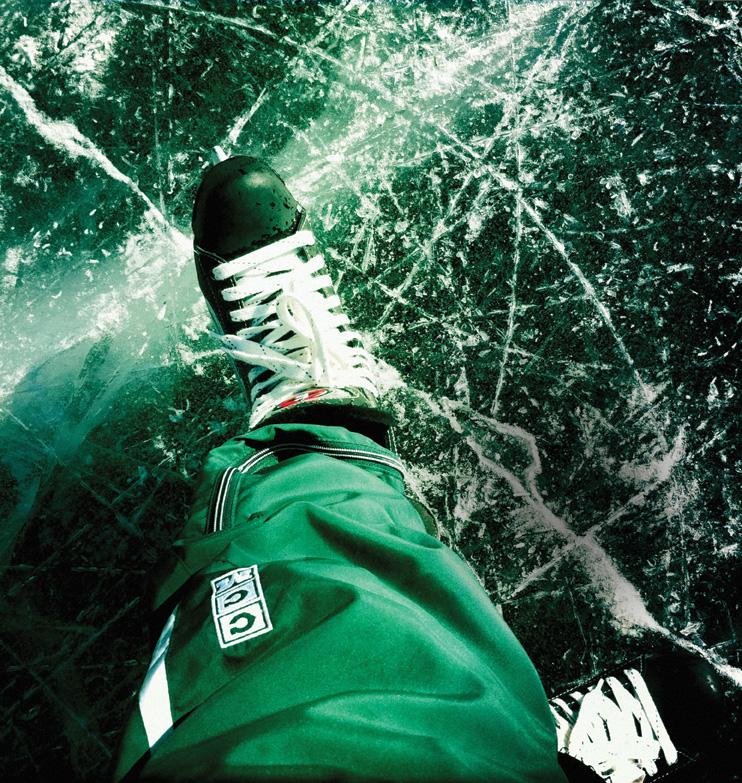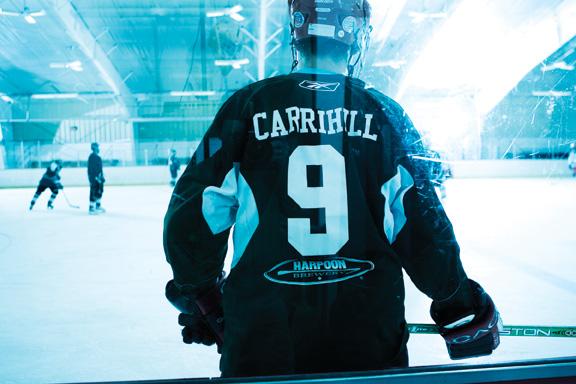A League of Our Own
Hockey is more than just a game at Tuck. It’s woven into the fabric of the school, an all-comers activity that builds on Tuck’s time-honored traditions of teamwork and community. But first you have to learn to stand on three legs.

Dan Lombard T’12 has played hockey all his life, but he’d never seen anything quite like this. It was 10 o’clock on a September weeknight, and Lombard, then a first-year MBA candidate at Tuck, had wandered down from his home at Sachem Village to the Tripod hockey tryouts at the James W. Campion III Rink.
The ice was crowded with some 60 first-year Tuck students, all of them looking haggard from the rigors of Fall A and bewildered by the mysterious ways of ice hockey. In the locker rooms, hand-lettered signs reminded players how to don layers of unfamiliar gear (shin pads before socks, skates before sweater). Music blared in the chill, fluorescent-lit arena, blending with laughter and the voices of experienced players herding prospects into two groups: those who could skate, and those who couldn’t. (See Photo Gallery.)
“It’s the first month of school, everyone is trying to get to know one another, and they’re out there kind of falling all over the place, smiling and laughing,” recalls Lombard, who starred at Yale and played professional hockey for four years. “I love the game, and to see people who had never been exposed to hockey enjoying it so thoroughly—that was a very cool moment.”
Lombard found himself grinning and laughing too, not so much at the ineptitude of the skaters—though there were enough pratfalls to fill a Three Stooges reel—but because the fun was so contagious. For Lombard, who’d hung up his skates and goalie pads in 2005 after a season facing shots from frustrated, locked-out NHL players in Sweden’s second-division Allsvenskan league, the Tripod tryouts were something of a revelation. While the professional game is fraught with stress, in Tuck’s Tripod leagues hockey is just a game. Students play for the joy of it.
Lombard had never stopped loving hockey, but the last time that it had only been about fun was back when he was a kid, when his coach was urging parents not to rush their kids home after games, no matter how harried their schedules. That coach knew that the lasting value of the game isn’t measured in the win-loss column. Spending time with teammates and forging friendships is every bit as important. “Hockey here at Tuck serves that same role,” Lombard says. “It’s a forum for people to challenge themselves with something new but also to build relationships.”

HOCKEY IS DEEPLY INGRAINED IN TUCK CULTURE. In the 1950s, and probably for decades before that, students would turn the lawn between Stell and Chase halls into a makeshift rink each winter, lashing the fire hose in the basement of Chase Hall to an iron grating and letting it run all night. The best players competed in Dartmouth’s intramural league, calling themselves the Tuck Tycoons. The Stell Hall rink, together with Occom Pond and any number of frozen puddles around campus, hosted frequent pickup games. Sometimes students wore skates, other times they played in shoes, but the second-years never failed to pass the hockey tradition on to the next class. From those humble beginnings, the Tuck Hockey Club has grown to include nearly 300 students, men and women, from former Division 1 college players to bare beginners. Tuck’s more-experienced A and B teams play against rival business schools and in the highly competitive Upper Valley Hockey League, while the Tuck Tripods, an all-comers league for students new to hockey, is the school’s most popular extracurricular activity. More than half of all first-year students play Tripod hockey, even though many have never been on skates before. It’s no wonder that when alumni visit campus, they want to talk about hockey. For many of them it was an integral part of the Tuck experience.
Dean Paul Danos regularly attends games, and administrators made sure that the new Achtmeyer and Pineau-Valencienne residence halls included vented gear lockers for hockey gear. (Before the buildings were completed in 2008, students stored their kit in pungent piles in residence hallways.) “The administration values Tuck hockey tremendously, but we don’t get involved other than to go to games. There’s no need,” says Assistant Dean Sally Jaeger. “It is totally student run and student organized.”
Almost any night in the fall and winter, Tuck students are playing hockey. The A and B teams defend home ice at the annual Tuck Hockey Club tournament and travel to tourneys hosted by Harvard Business School and the Molson School of Business at Concordia University in Montreal. They also play weekly games in the Woodstock, Vt., town leagues and help Tripod players learn the nuances of the game. The 10 Tripod teams—four women’s and six men’s—play two full seasons a year, each with playoffs and a championship game.
Add to these regular-season games and such crowd-pleasing matchups as the annual Valentine’s Day Massacre (in which spouses and partners play on opposing teams) and the self-described Salsa vs. Curry game, featuring Tripod players from Latin America and Asia. There’s even an all-star game of sorts, in which the top Tripod players take on the B team.

Like other Tripod recruits, Deese’s hockey journey began at the annual hockey-gear sale, part of a student-organized program that allows graduating players to sell their used hockey kit to the next generation of Tripods. New players can buy a full set of used hockey gear for about $180 and can sell it back for $100 when they leave Tuck two years later. On swap day, the lawn in front of WhittemoreHall takes on the air of an adrenaline-charged flea market, as wide-eyed recruits peruse tables piled high with skates, pads, jerseys, and less-familiar hockey accoutrements. Veteran players offer encouragement and advice, helping prospects make sense of the game’s more mysterious paraphernalia. They reveal that hockey players do indeed wear garter belts under all those pads, and if asked they’ll explain why—and how. Purchased new, a full set of hockey gear starts at about $400. The buyback program reduces the cost of entry to less than $100 and is a big factor in the popularity of Tripod hockey at Tuck.
New Tripods leave the swap with everything they need for the next big event on the Tuck hockey calendar: tryouts. The label is something of a misnomer, because there are no cuts in Tripod hockey. All are welcome, and everyone gets a chance to play. Imagine a Little League in which the grown-ups are actually playing, rather than shouting from the sidelines, and you’ll have a good idea of what Tripod hockey is all about.
Hockey is not an easy game to learn, especially for busy students in the waning years of their athletic prime, but Tuck makes the entry as easy as possible. “We had captains and volunteers from the A team teaching people how to skate, how to stop, and how to fall,” recalls Kelly Sennatt T’12, who needed less help than most. As a girl growing up in Connecticut and Philadelphia, she’d dabbled in figure skating, and though she didn’t know the rules of the game or even how to hold a stick, she could skate backwards. That skill was enough to make Sennatt a pick in the annual Tuck Hockey League draft, in which the top 20 male and 10 female Tripod prospects are assigned to teams.
“It’s like a roast,” says Deese, who was drafted last year and helped organize this fall’s event. “It’s a way to welcome first-years into hockey and let them know that while we do take the games seriously on the ice, it’s all in good fun.” In true business-school fashion, each drafted player is introduced with humorous PowerPoint slides and photos culled from Facebook and other social-networking sites. The slides typically bestow a nickname and include the player’s hometown, college, and the ostensible reason they were drafted. “Every year there’s a Canadian who can’t skate but who gets drafted anyway,” Sennatt says. “One girl got drafted because she had pictures of herself playing powder-puff football on Facebook.”
The draft-night tradition provides a welcome break from the stress of Fall A, but it serves a larger purpose as well. “There aren’t many activities at Tuck where first-years, second-years, and partners are all involved at the same time,” Sennatt says. Tripod hockey is more than a bunch of wobbly players leaning on their sticks; it’s part of the glue that holds the Tuck community together, says Sennatt, who counts the T’11s she played with last year among her closest friends at Tuck.
THE ADVANTAGE TO STARTING A NEW SPORT FROM SCRATCH IS THAT YOU CAN ONLY GET BETTER.Hockey is a harder game to learn than most, and skills learned in other sports don’t transfer easily. “You would think it’s easy to transition from lacrosse to hockey, because you have a stick. The difference is I’m no longer running; I’m skating,” says Deese, who has played lacrosse since the fourth grade. “You’re playing on this completely alien surface. There’s nothing like it.”

“Hockey was such a positive thing in my life, so the fact that they played hockey at Tuck and that it was so accessible to everybody contributed to my decision to come here,” he says. The challenge of learning a new game, contributing to a team, and competing together in an unfamiliar environment is similar in many ways to Tuck’s project-based team learning approach. “Hockey embodies the Tuck experience because it’s a fairly intensive commitment to a sport that almost no one has played, with a completely foreign surface,” Zwald says. “And yet so many people come out and play. Tuck hockey has got such a strong sense of community.”
Zwald attends Tripod games and, like many members of the A and B teams, helps coach Tripod players. “In my study groups, I lean on people with a finance background to get me up to speed, so here’s a little way that I can help contribute,” he says. Lombard, too, enjoys helping new players learn to skate—making Tuck one of the few places in the hockey world where a 28-year-old novice can receive personalized instruction from a former professional. Lombard, though, is the first to say that as a Tripod coach, his playing pedigree means little. “Keep in mind that some of these people have literally just put on skates for the first time,” he says. “Anyone who has played before can be hugely helpful.”
The Tripod players’ commitment to learning hockey inspired Lombard to set a challenge for himself. “I had always played as a goalie, and I decided at Tuck that I was going to skate out as a defenseman. It was humbling how bad I was as a defenseman, but it took me back to what I love about hockey,” says Lombard, who has relished the challenge of playing the new position in such a carefree environment. There is no pressure at Tuck games, no promotion to the big leagues at stake. There’s just the joy of hockey and the satisfaction of watching new converts master the game. “Derrick Deese really jumped into it, and he’s become a real leader. I’ve skated with him—he’s really good. It’s unbelievable how much better people get,” Lombard says.
Early-season Tripod games can be almost comical to watch, but as players gain experience and study the game—Tuck students are goal-oriented achievers, after all—the skating becomes more confident. Passes become crisper, the shots on goal more accurate. Teams begin to learn the rhythm of the game and of each other. Without ever crowding out the sense of fun, the players’ innate competitive natures begin to emerge as their skills improve. “Once the playoffs start, you’ll see the intensity pick up,” Deese says. “There’s no checking, but you’ll see people running into each other and getting a little chippy on the ice.”
"We’re all bad hockey players, let’s just stipulate that. But some people have never seen ice before.” —Derrick Deese T’12
Skating as the Pussycat Dolls, Sennatt’s team claimed the fall 2010 Tripod title. Now calling themselves the Switchback Sweeties, they’re competing for the winter-term crown. (The Tripod leagues choose a naming theme each season. Last fall the women’s teams were named after female pop bands; in the winter they chose local breweries. The men’s Tripods recently riffed on the names of Tuck administrators and faculty, with Jaeger’s Meisters honoring Sally Jaeger and the Kleinbombers referencing strategy professor Adam Kleinbaum.)
The game was close, and Sennatt scored a goal. Though she doesn’t recall the final score, she does remember winning the championship and taking the Picotte Cup to Murphy’s afterward. In that way, the big game was like any other Tripod contest. “You get out of a game at 12:30 in the morning, and you’re pretty wired because your adrenaline’s up,” Deese says. “The best option is to go to Murphy’s for a beer.” Though one would expect turnout for games starting at 10 or 11 p.m. to be poor, the games are well attended—especially when the course load is heavy. “You may have homework or a test the next day, but people are still out there skating. They make it a priority,” Deese says.
Hockey provides an escape from the academic rigors of business school but in a way that augments the teamwork and camaraderie that is so integral to the Tuck experience. “I didn’t realize the extent to which hockey is a part of the tradition and culture here,” Sennatt says. Playing hockey one or two times a week and having a beer afterward takes you out of the stress, especially of first year. It’s 9 o’clock at night, and you say, ‘OK, I’m going to put down the books and go play hockey.’”